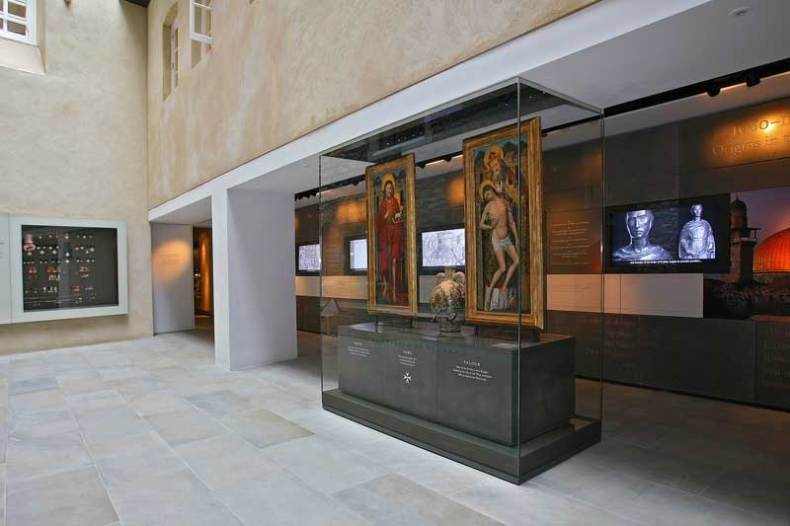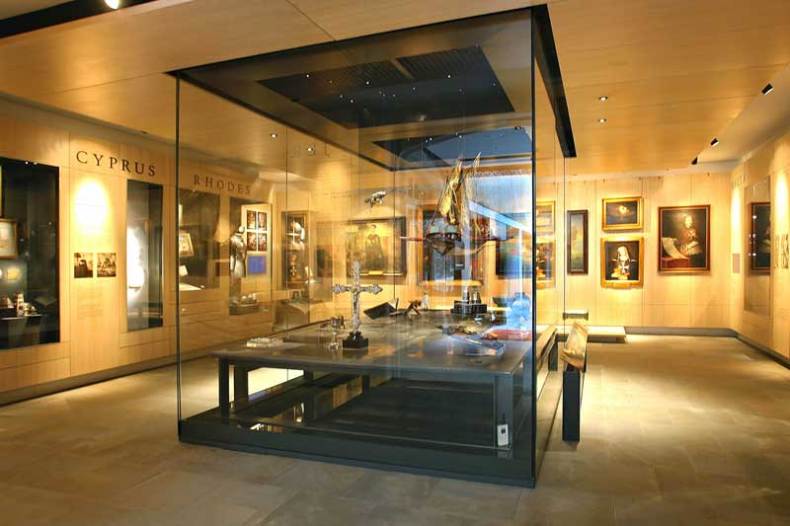Judging by the many what’s on guides to London, one would be forgiven for assuming that the city is bursting at the seams with secret treasures and hidden gems. One such attraction, perhaps to be taken with a pinch of salt, is ‘Caravaggio’s’ The Cardsharps (1595) on loan to the rather unassuming Museum of the Order of St John in Clerkenwell.
The collection ties our own humble St John’s Ambulance volunteers to a mysterious group of wealthy, crusading doctors from the distant past. The institution’s remarkable, and occasionally clandestine, history lends the museum an air of Dan Brown-like mystery.
The collection is put to didactic use, chronicling the Order’s fortunes over the last millennium. This is an altogether different way of consuming art. Panels from the Weston Triptych (c. 1480), by a follower of Rogier van der Weyden, share a display case with a medieval sword. Likewise, a 16th-century portrait of the Florentine patrician, Leone Strozzi, hangs alongside Iznik tiles and a magnificent cannon presented by Henry VIII to the excellently titled Grand Master Philippe Villiers de L’Isle-Adam.

The Link Gallery at the Museum of the Order of St John
The Cardsharps is surely also the only ‘Caravaggio’ in the world to sit beside a 19th-century wooden ambulance. Its addition to this eclectic display is a major coup for such a small museum. The work belonged to the late Sir Denis Mahon, whose generous and celebrated bequest of 57 Italian Baroque paintings to the nation includes masterpieces by the likes of Luca Giordano, Guido Reni and Guercino. This work, by contrast, has proved rather controversial.
Mahon stipulated that the work must remain on public display. Originally offered to the Ashmolean Museum in Oxford, the loan fell through due to reservations over the collector’s attribution to Caravaggio. Nagging doubts have persisted, not least at Sotheby’s, who sold the painting to Mahon in 2006 for £50,400 as the work of a follower and, in the wake of the seller’s subsequent suit for damages, are keen to distance themselves from any associations with this most lucrative of artists.
Mahon had already discovered the now universally accepted version of The Cardsharps in 1985, now in the Kimbell Art Museum at Fort Worth, Texas. Then he found another one – a bargain at twice the price. The Clerkenwell Museum’s press release states that, ‘after exhaustive study and scientific analysis, Sir Denis concluded that this was an earlier version’. I have my own ill-informed suspicions regarding the painting’s authorship, but these are largely irrelevant in its current location.

The Order Gallery at the Museum of the Order of St John
Freed from any connoisseurial constraints, the present museum is at liberty to use the painting to tell the story of the Order’s greatest artist. Everyone’s favourite ‘troubled’ genius, Caravaggio became a Knight of the Order after fleeing to Malta to escape accusations of murder in 1606.
The ambiguity surrounding The Cardsharps would have undermined the likes of the Ashmolean or National Gallery. These institutions derive authority from the (occasionally optimistic) assertion that their collections are unequivocally authentic. However, this kind of art-historical posturing is of little concern to the Museum of the Order of St John. Like me, you may go there for The Cardsharps, but end up staying for the rich stories.
The Museum of the Order of St John is in Clerkenwell, London.
Related articles
Fixed Price: how we value fake and damaged art (Katy Barrett)

Play Your Cards Right
The Cardsharps, attributed to Caravaggio © Private collection, London
Share
Judging by the many what’s on guides to London, one would be forgiven for assuming that the city is bursting at the seams with secret treasures and hidden gems. One such attraction, perhaps to be taken with a pinch of salt, is ‘Caravaggio’s’ The Cardsharps (1595) on loan to the rather unassuming Museum of the Order of St John in Clerkenwell.
The collection ties our own humble St John’s Ambulance volunteers to a mysterious group of wealthy, crusading doctors from the distant past. The institution’s remarkable, and occasionally clandestine, history lends the museum an air of Dan Brown-like mystery.
The collection is put to didactic use, chronicling the Order’s fortunes over the last millennium. This is an altogether different way of consuming art. Panels from the Weston Triptych (c. 1480), by a follower of Rogier van der Weyden, share a display case with a medieval sword. Likewise, a 16th-century portrait of the Florentine patrician, Leone Strozzi, hangs alongside Iznik tiles and a magnificent cannon presented by Henry VIII to the excellently titled Grand Master Philippe Villiers de L’Isle-Adam.
The Link Gallery at the Museum of the Order of St John
The Cardsharps is surely also the only ‘Caravaggio’ in the world to sit beside a 19th-century wooden ambulance. Its addition to this eclectic display is a major coup for such a small museum. The work belonged to the late Sir Denis Mahon, whose generous and celebrated bequest of 57 Italian Baroque paintings to the nation includes masterpieces by the likes of Luca Giordano, Guido Reni and Guercino. This work, by contrast, has proved rather controversial.
Mahon stipulated that the work must remain on public display. Originally offered to the Ashmolean Museum in Oxford, the loan fell through due to reservations over the collector’s attribution to Caravaggio. Nagging doubts have persisted, not least at Sotheby’s, who sold the painting to Mahon in 2006 for £50,400 as the work of a follower and, in the wake of the seller’s subsequent suit for damages, are keen to distance themselves from any associations with this most lucrative of artists.
Mahon had already discovered the now universally accepted version of The Cardsharps in 1985, now in the Kimbell Art Museum at Fort Worth, Texas. Then he found another one – a bargain at twice the price. The Clerkenwell Museum’s press release states that, ‘after exhaustive study and scientific analysis, Sir Denis concluded that this was an earlier version’. I have my own ill-informed suspicions regarding the painting’s authorship, but these are largely irrelevant in its current location.
The Order Gallery at the Museum of the Order of St John
Freed from any connoisseurial constraints, the present museum is at liberty to use the painting to tell the story of the Order’s greatest artist. Everyone’s favourite ‘troubled’ genius, Caravaggio became a Knight of the Order after fleeing to Malta to escape accusations of murder in 1606.
The ambiguity surrounding The Cardsharps would have undermined the likes of the Ashmolean or National Gallery. These institutions derive authority from the (occasionally optimistic) assertion that their collections are unequivocally authentic. However, this kind of art-historical posturing is of little concern to the Museum of the Order of St John. Like me, you may go there for The Cardsharps, but end up staying for the rich stories.
The Museum of the Order of St John is in Clerkenwell, London.
Related articles
Fixed Price: how we value fake and damaged art (Katy Barrett)
Unlimited access from just $16 every 3 months
Subscribe to get unlimited and exclusive access to the top art stories, interviews and exhibition reviews.
Share
Recommended for you
Affordable Art
A new 50p piece, designed by Tom Phillips to celebrate the centenary of Benjamin Britten’s birth, attempts to ‘set the wild echoes flying’
Small Wonders: Penlee House
6000 years of Cornish history in one museum: Louise Connell introduces Penlee House Gallery & Museum in Penzance
Well Met
Art and archaeology aren’t neat categories at the best of times. At the Metropolitan Museum of Art, they’re allowed to overlap